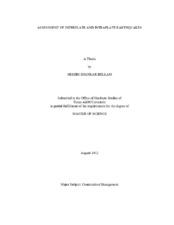| dc.contributor.advisor | Nichols, John M. | |
| dc.creator | Bellam, Srigiri Shankar | |
| dc.date.accessioned | 2012-10-19T15:30:45Z | |
| dc.date.accessioned | 2012-10-22T18:03:48Z | |
| dc.date.available | 2014-11-03T19:49:15Z | |
| dc.date.created | 2012-08 | |
| dc.date.issued | 2012-10-19 | |
| dc.date.submitted | August 2012 | |
| dc.identifier.uri | https://hdl.handle.net/1969.1/ETD-TAMU-2012-08-11713 | |
| dc.description.abstract | The earth was shown in the last century to have a surface layer composed of large plates. Plate tectonics is the study of the movement and stresses in the individual plates that make up the complete surface of the world's sphere. Two types of earthquakes are observed in the surface plates, interplate and intraplate earthquakes, which are classified, based on the location of the origin of an earthquake either between two plates or within the plate respectively. Limited work has been completed on the definition of the boundary region between the plates from which interplate earthquakes originate, other than the recent work on the Mid Atlantic Ridge, defined at two degrees and the subsequent work to look at the applicability of this degree based definition. Others suggested an alternative view of a constant width for the interplate region in recent work at Texas A&M University.
The objective of the paper is to determine whether the assumption of a linear width of the region along the tectonic plate boundaries to classify earthquakes as interplate and intraplate earthquakes using accepted statistical criteria provides a better fit to the data than the constant degree definition.
There are three types of interplate boundaries defined by the relative movement of the two plates to each other, which further complicates this study. The study used a nonrandom analysis of regions of the different types of boundary to compare the rate and decay of the intraplate earthquakes from a notional centerline for the known boundaries. The study used GIS software and EXCEL for the statistical analysis component of the research work.
The results show that a constant width definition provides a number of advantages in determining the relative definition of interplate and intraplate earthquakes when compared to the constant degree definition developed for work on the Mid Atlantic Ridge. Further research is suggested on a randomly selected set of study sites to improve the reliability and quality of the statistical work for each type of the boundary of the tectonic plates. | en |
| dc.format.mimetype | application/pdf | |
| dc.language.iso | en_US | |
| dc.subject | Earthquakes | en |
| dc.subject | Interplate | en |
| dc.subject | Intraplate | en |
| dc.subject | Seismic | en |
| dc.subject | USGS | en |
| dc.subject | NOAA | en |
| dc.subject | Tectonic Plate Boundaries | en |
| dc.subject | Plate Tectonics | en |
| dc.title | Assessment of Interplate and Intraplate Earthquakes | en |
| dc.type | Thesis | en |
| thesis.degree.department | Construction Science | en |
| thesis.degree.discipline | Construction Management | en |
| thesis.degree.grantor | Texas A&M University | en |
| thesis.degree.name | Master of Science | en |
| thesis.degree.level | Masters | en |
| dc.contributor.committeeMember | Nichols, Anne B. | |
| dc.contributor.committeeMember | Wunneburger, Douglas F. | |
| dc.contributor.committeeMember | Feigenbaum, Leslie H. | |
| dc.type.genre | thesis | en |
| dc.type.material | text | en |
| local.embargo.terms | 2014-10-22 | |


